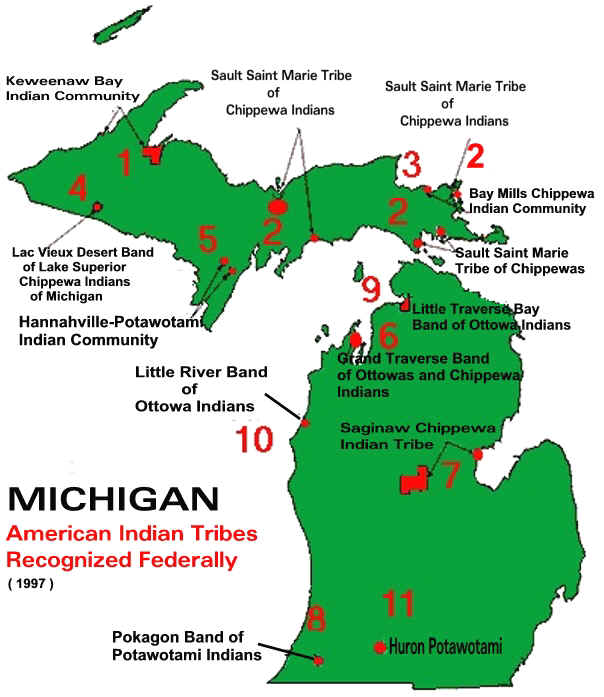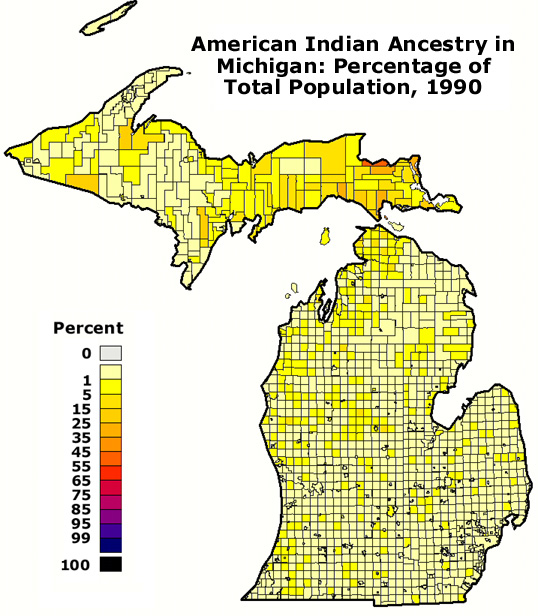During the 1900s, many Michigan Indians lived in poverty. They received money from government treaties, but spent it quickly. The buffalo and deer herds were almost gone. They struggled to have enough food to feed their families. The people tried different ways to survive. Ways of survival ranged from some Indians becoming seasonal migrant workers, who were paid little, to simply trying to farm the little land that they had left. This once resourceful and thriving people was now going through a horrible period of societal decline that was taking its toll on all Indians.
In 1934 the Indian Reorganization Act was passed. It began to turn their life of poverty around. This was a plan to stop Indians from losing more reservation land. The government promised to help the Indians make economic improvements. It also let the Indian communities form community governments and manage their own businesses. They set up their own governments and wrote their own Constitutions. Not all of the communities agreed with this new act for various reasons. Some refused to accept it, but many others benefited from it in the end.

Source: Unknown
During the 1970s the Indians started to speak out about how they had
been unfairly treated by the U.S. and its government. Hundreds of Indians participated in
marches in Washington D.C. to make people aware of their needs and rights. These marches
were seen on TV, and read about in newspapers. Many soon became aware of what issues
Indians had and how these wrongs should be addressed. After all this publicity, The Indian
Self-Determination and Education Assistance Act of 1975 was passed by Congress. This gave
the Indians more opportunities to make important decisions that would affect their
communities. Since then they have made many improvements in their communities.
Later on, many Indian Tribes like the Potawatomi
needed more money than what they received through government grants to make the
improvements to their reservation and such. They then began to plan ways to bring in more
money for their reservations. One way that some Indians are bringing in a lot of money
today is by operating gaming facilities on their reservations. The Potawatomi have been
one of the lucky tribes in the gaming area however. Some tribes have not shown an ability
to make these casinos work. Though a somewhat risky venture, this group is making it come
together for the good of the tribe. The Potawatomi have
realized how important it is for their people to have a good education. They have worked
hard to make improvements in education for their children and their adults.
They are working to have healthy communities by improving health care.
They are building new clinics to provide good medical care of all ages on the
reservations. Dreams of having a better life are finally coming true for the Potawatomi
Indians. They are working hard to create programs that will help all of their members to
have a life free of poverty and hardship. The last few years have been
years of opportunities for the Potawatomi. As their economy has grown, their quality of
life has improved dramatically. Programs have been started to upgrade their education and
health care. While they are trying to solve some of the social problems that exist among
the bands, they look forward to a successful 21st century.

Source: U.S. Bureau of the Census
Boundary file: Michigan Information Center
Source: Michigan State University, Department of Geography
Indian gaming
With many Native Americans hovering at or below the poverty level today, many have seen
some of the economic success in Indian gaming and regard it as their chance to re-emerge
into a comfortable way of life. Seeing these casinos as the new buffalo, which relates to
the times when Indians thrived here in America, many Indian in Michigan and beyond simply
want a chance at success once again. The message from the tribes is that they want jobs,
not welfare. A recent opinion poll showed that 70% of Americans support Indian gaming.
On the upside of this casino movement, some tribes are using their
casino profits to establish college scholarships for their young people, to construct
health clinics and hospitals, build new schools and day-care centers, open hotels,
restaurants, gas stations, and flower shops; to fund retirement programs for their tribal
elders, and to make long-term investments in hydroelectric as well as manufacturing
plants.
But others are not planning for their future. They're taking today's
profits and squandering them. There are also questions about where some of the money is
going. Statistically speaking, only a small percentage of American Indians derive direct
benefit from the operation of the casinos. Instead of giving tribal members per
capita monthly payments, Indian tribes could be using gaming profits to purchase more land
and expand their reservation base. Along with the salvation afforded American
Indians by the arrival of the "new buffalo," gaming is a two-edged sword.
In the late 1980s, a sweet series of Indian triumphs had left some
bitter aftertaste. Some recognized tribes won the right to run high-stakes gambling,
regardless of prohibitions in bordering states. The result is a handful became fabulously
wealthy, and some financial benefits started to accrue to impoverished reservations. But
friction increased between recognized and unrecognized tribes. Indian gambling has
exploded to more than 89 casinos and 170 high-stakes bingo games in 24 states, with more
opening almost every month (as of 2001). Half of the nation's 318 federally
recognized tribes, with a total of 1.9 million members - are trying to get involved in
gambling. To date, surprisingly few have benefited.
Source: Unknown
Indian gaming represents only about 5% of all gambling in the United States and only a
third of tribes currently operate gaming facilities. About 40% of gambling revenues come
from state lotteries and the remaining 55% is dominated by commercial entities in Nevada
and New Jersey. While some tribes have earned millions, others remain mired in
poverty. The problems of the Indian reservations include a 24% poverty rate, a suicide
rate more than twice that of all other nonwhites, and the highest high school dropout rate
among all non-whites. Many Indians live on remote lands with no resources. The federal
government has reduced economic assistance by two-thirds over the last 15 years.
Unemployment still averages 45%.
Thanks to Ryan Wurtzel, a former GEO 333 student, for
help with this page.
This material has been
compiled for educational use only, and may not be reproduced without
permission. One copy may be printed for personal use. Please contact
Randall Schaetzl (soils@msu.edu)
for more information or permissions.